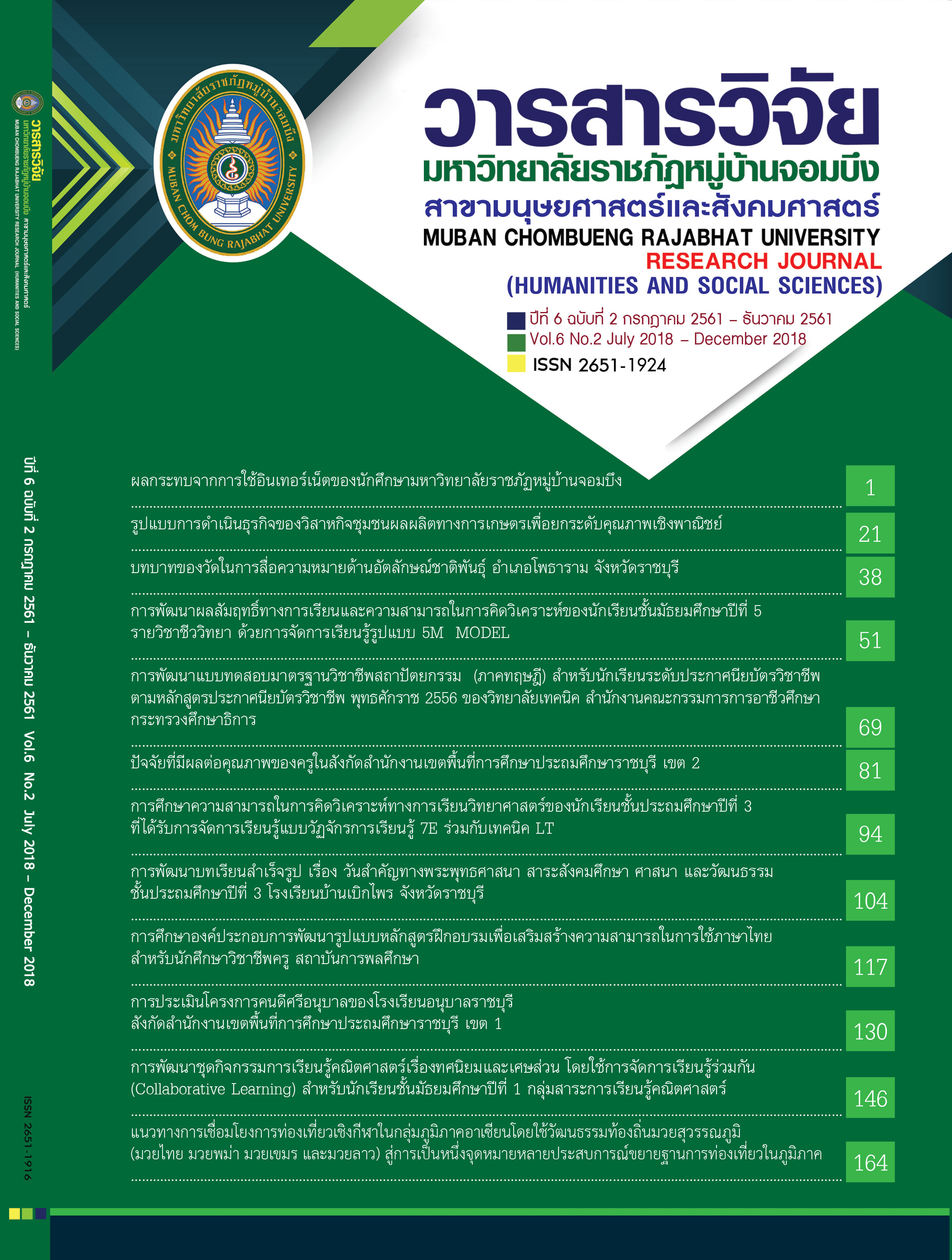การศึกษาความสามารถในการคิดวิเคราะห์ทางการเรียนวิทยาศาสตร์ของนักเรียน ชั้นประถมศึกษาปีที่ 3 ที่ได้รับการจัดการเรียนรู้แบบวัฏจักรการเรียนรู้ 7E ร่วมกับเทคนิค LT
คำสำคัญ:
ความสามารถในการคิดวิเคราะห์, การจัดการเรียนรู้แบบวัฏจักรการเรียนรู้ 7E, เทคนิค LTบทคัดย่อ
การวิจัยครั้งนี้ มีวัตถุประสงค์เพื่อ 1) เปรียบเทียบความสามารถในการคิดวิเคราะห์ของนักเรียนชั้นประถมศึกษาปีที่ 3 ก่อนและหลังการใช้การจัดการเรียนรู้แบบวัฏจักรการเรียนรู้ 7E ร่วมกับเทคนิค LT และ 2) เปรียบเทียบความสามารถในการคิดวิเคราะห์ของนักเรียนชั้นประถมศึกษาปีที่ 3 ที่ได้รับการจัดการเรียนรู้แบบวัฏจักรการเรียนรู้ 7E ร่วมกับเทคนิค LT กับแบบปกติ กลุ่มตัวอย่าง ได้แก่ นักเรียนชั้นประถมศึกษาปีที่ 3 ภาคเรียนที่ 1 ปีการศึกษา 2560 จำนวน 1 โรงเรียน สุ่ม 2 ห้อง โดยใช้วิธีการสุ่มแบบกลุ่มหลายขั้นตอน (Multi - Stage cluster random sampling) แบ่งเป็น กลุ่มทดลอง 1 ห้อง จำนวน 25 คน และกลุ่มควบคุม 1 ห้อง จำนวน 25 คน โดยใช้เวลาในการทดลอง 9 สัปดาห์ สัปดาห์ละ 2 ชั่วโมง รวมเป็น 18 ชั่วโมง เครื่องมือที่ใช้ในการวิจัย ได้แก่ แบบทดสอบความสามารถในการคิดวิเคราะห์ ที่มีค่าความเชื่อมั่น .974 ของนักเรียนชั้นประถมศึกษาปีที่ 3 ที่ได้รับการจัดการเรียนรู้แบบวัฏจักรการเรียนรู้ 7E ร่วมกับเทคนิค LT ที่มีค่าความเชื่อมั่น .951 ดำเนินการทดลองตามแบบแผนการวิจัยแบบ Randomized Control – Group Pretest – Posttest Design การวิเคราะห์ข้อมูล โดยใช้สถิติ ร้อยละ ค่าเฉลี่ย ส่วนเบี่ยงเบนมาตรฐาน ค่าที (t-test) แบบ Dependent และแบบ Independent และการวิเคราะห์เนื้อหา (Content analysis)
ผลการวิจัย พบว่า 1) นักเรียนชั้นประถมศึกษาปีที่ 3 มีความสามารถในการคิดวิเคราะห์หลังเรียน โดยใช้การจัดการเรียนรู้แบบวัฏจักรการเรียนรู้ 7E ร่วมกับเทคนิค LT สูงกว่าก่อนเรียนอย่างมีนัยสำคัญทางสถิติที่ระดับ .01 และ 2) หลังเรียนนักเรียนที่ได้รับการจัดการเรียนรู้แบบวัฏจักรการเรียนรู้ 7E ร่วมกับเทคนิค LT มีความสามารถในการคิดวิเคราะห์สูงกว่านักเรียนที่ได้รับการจัดการเรียนรู้แบบปกติ อย่างมีนัยสำคัญทางสถิติที่ระดับ .01
เอกสารอ้างอิง
_______. (2555ข). บัณฑิตศึกษาในทศวรรษที่ 21 : การปรับหลักสูตรและการสอน. เอกสารประกอบการประชุมวิชาการของราชบัณฑิตยสถานร่วมกับมหาวิทยาลัยราชภัฏวไลยอลงกรณ์ ในพระบรมราชูปถัมภ์.
ธัญวลัยกรณ์ ศรีเทพ. (2557). การพัฒนากิจกรรมการเรียนการสอนวิทยาศาสตร์ โดยใช้รูปแบบ การเรียนการสอนตามวงจรการเรียนรู้ 7E และแหล่งเรียนรู้ในชุมชนเป็นฐาน หน่วยการเรียนรู้ การปลูกพืช เลี้ยงสัตว์ ชั้นประถมศึกษาปีที่ 2. วิทยานิพนธ์ครุศาสตรมหาบัณฑิต สาขาหลักสูตรและการสอน มหาวิทยาลัยราชภัฏสกลนคร.
บัวผัน คะเนนอก. (2553). การจัดกิจกรรมการเรียนรู้ด้วยกลุ่มร่วมมือ เทคนิค LT เรื่อง วัสดุ และสมบัติของวัสดุ กลุ่มสาระการเรียนรู้วิทยาศาสตร์ ชั้นประถมศึกษาปีที่ 5. วิทยานิพนธ์การศึกษามหาบัณฑิต สาขาวิชาหลักสูตรและการสอน มหาวิทยาลัยมหาสารคาม.
พิมพันธ์ เดชะคุปต์. (2544). การเรียนการสอนที่เน้นผู้เรียนเป็นสำคัญ แนวคิด วิธีและเทคนิค
การสอน 2. กรุงเทพฯ: เดอะมาสเตอร์กรุ๊ป แมเนจเม้นท์.
รติพร ศรีลาดเลา. (2551). เปรียบเทียบผลการเรียนรู้แบบวัฏจักรการเรียนรู้ 7E และแบบวัฏจักร
การเรียนรู้ 5E ที่มีต่อผลสัมฤทธิ์ทางการเรียน การวิเคราะห์ และเจตคติเชิงวิทยาศาสตร์
ของนักเรียนชั้นมัธยมศึกษาปีที่ 5. วิทยานิพนธ์การศึกษามหาบัณฑิต สาขาหลักสูตรและการสอน มหาวิทยาลัยมหาสารคาม.
รายงานการประเมินตนเอง. (2558). Self Assessment Report: SAR. สระบุรี: เทศบาลเมืองสระบุรี
สถาบันส่งเสริมการสอนวิทยาศาสตร์และเทคโนโลยี. (2546). การจัดสาระการเรียนรู้กลุ่มวิทยาศาสตร์ หลักสูตรการศึกษาขั้นพื้นฐาน. กรุงเทพฯ: ผู้แต่ง.
อาภรณ์ ใจเที่ยง. (2550). หลักการสอน. กรุงเทพฯ: โอเดียนสโตร์.
Eisenkroft, A. (2003). Expanding the 5-E Model A Proposed 7-E Model Emphasizes Transfer of Learning and the lmpolisrtance of Ekciting Prior Understanding. The Science Teacher. 70(6 September), 56-59.
ดาวน์โหลด
เผยแพร่แล้ว
รูปแบบการอ้างอิง
ฉบับ
ประเภทบทความ
สัญญาอนุญาต
วารสาร TCI อยู่ภายใต้การอนุญาต Creative Commons Attribution-NonCommercial-NoDerivatives 4.0 International (CC BY-NC-ND 4.0) เว้นแต่จะรุบุไว้เป็นอย่างอื่นโปรดอ่านหน้านโยบายของเราสำหรับข้อมูลเพิ่มเติมเกี่ยวกับการเช้าถึงแบบเปิด ลิขสิทธิ์ และการอนุญาต



